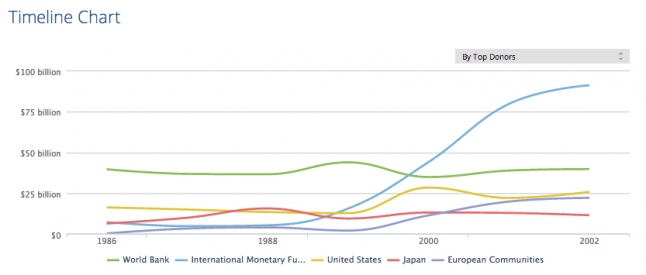Does aid strengthen or undercut labor rights in developing countries? In a recent study, Reed Wood, an Assistant Professor of Political Science at Arizona State University, analyzes the impact of development assistance on labor rights in 90 less developed countries (LDCs). Wood’s paper, “Aiding Labor: Foreign Aid and the Promotion of Labor Rights in LDCs,” suggests that official development assistance has the greatest impact on labor rights when the aid effectively empowers labor unions related to civil society groups and non-governmental organizations within recipient countries. But what does this look like in practice?
Using AidData’s development finance data for the years 1986-2002, Wood finds that official development assistance can influence a recipient country’s labor rights in two ways: direct assistance and diffusion.

The above image represents the breakdown of development finance by top donor between 1986 and 2002 from the AidData database.
First, aid can directly flow from donors to civil society groups and NGOs that promote labor rights or related human rights within developing countries. Aid can also influence civil society groups and NGOs that address complementary issues such as improving the organizational capacity of labor unions and increasing their ability to mobilize and advocate for their concerns.
Second, official development assistance can indirectly promote greater respect for labor rights through diffusion. In these cases, donor countries with stronger labor rights standards transfer these norms and behavioral practices to countries receiving assistance. In the study, Wood uses Labor Practice scores as an indicator of donor and recipient states’ respect for labor rights in practice. (Note: In this analysis higher values reflect greater respect for workers’ rights.) For example, in 2002 the United States received a labor practice score of 21.5, Japan received a 23, and Sweden received a 27.5. By contrast, Saudi Arabia and the UAE received scores of 11.5 and 7.25, respectively. According to this measure, countries like Sweden should have a much stronger diffusion effect than countries like Saudi Arabia, yet both are contributing aid to the LDCs in regions like the Middle East.
The type of assistance and source country providing the aid are important factors influencing how effective aid will be in strengthening labor rights within recipient countries. Wood’s study demonstrates that greater flows of aid devoted to NGOs and civil society groups increase recipient states’ respect for labor rights. If the goal is to improve labor rights, simply increasing general development assistance to LDCs is not the most efficient method. Instead, aid should be targeted towards NGOs and civil society groups that will work to empower labor unions. Even in cases where improving labor rights is not the specific end goal, donors with stronger labor rights standards may be able to enhance the ultimate impact of their assistance through encouraging new norms and behaviors that increase the prospects of diffusion.
Quantitative evidence found in the study supports the idea of diffusion. Greater shares of aid from donors with superior labor rights standards increase the respect for labor rights in recipient states. In order to quantify donor influence on labor rights, Wood did an analysis between two variables: an Aid Context score (which reflects the weighted average of donor labor practices) and a Labor Practice score. The study showed that a country with an aid context score of 24 is predicted to have a labor practice score of just over 20. If the aid context score is increased to 27, the labor practice score increases to 21. Although these improvements seem marginal, Wood’s analysis only predicted changes that would occur within three years, suggesting that in the long run the aggregate influence could be substantial.
As with trade and investment, aid has proven to be a significant way to share norms between developed and less developed states. In terms of the influence of aid on labor rights, donors should remember that both the type and the source of aid matters when predicting how labor rights standards will be influenced in recipient countries.
